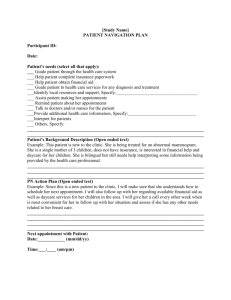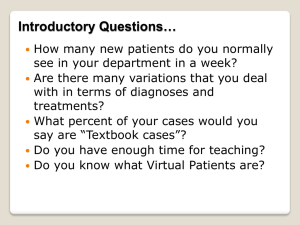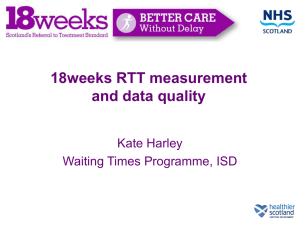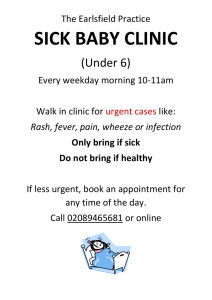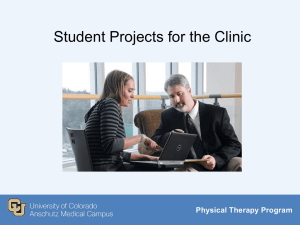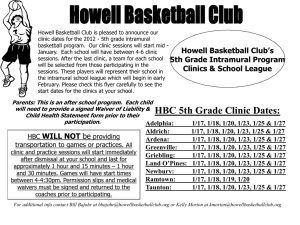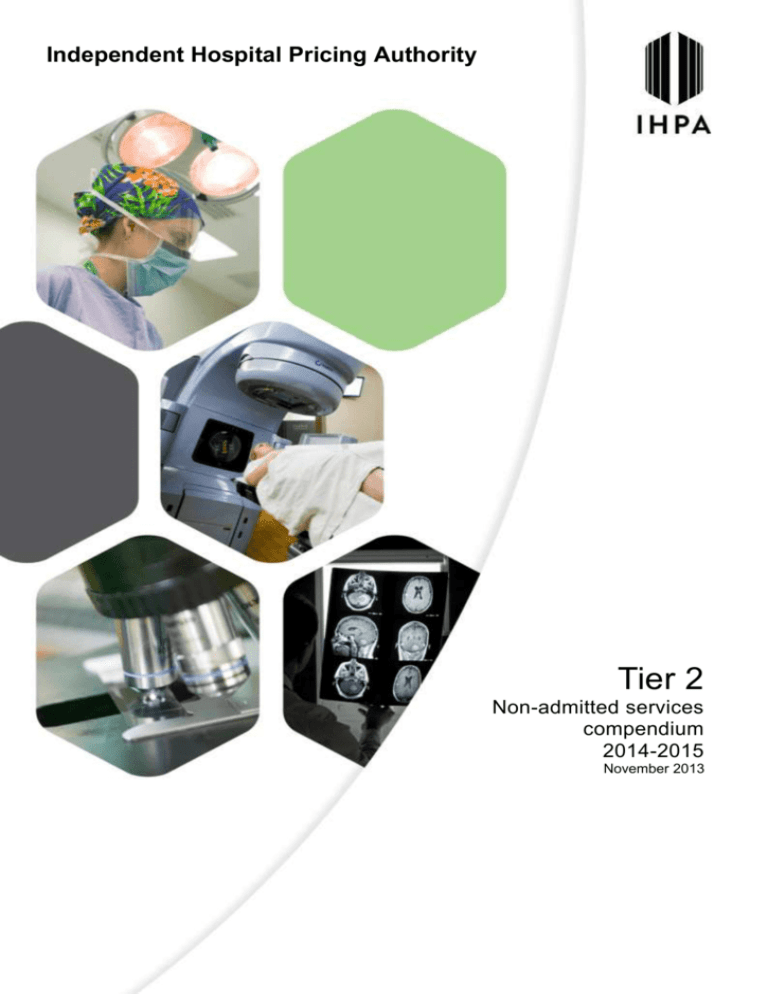
Independent Hospital Pricing Authority
Tier 2
Non-admitted services
compendium
2014-2015
November 2013
Tier 2 Non-admitted services compendium 2014-15
Tier 2 Non-admitted services compendium 2014-15
Online ISBN:
Copyright Statements:
Internet sites
© Commonwealth of Australia 2012
This work is copyright. You may download, display, print and reproduce the whole or part of
this work in unaltered form for your own personal use or, if you are part of an organisation,
for internal use within your organisation, but only if you or your organisation do not use the
reproduction for any commercial purpose and retain this copyright notice and all disclaimer
notices as part of that reproduction. Apart from rights to use as permitted by the Copyright
Act 1968 or allowed by this copyright notice, all other rights are reserved and you are not
allowed to reproduce the whole or any part of this work in any way (electronic or otherwise)
without first being given the specific written permission from Independent Hospital Pricing
Authority to do so.
Independent Hospital Pricing Authority
Page 1 of 24
Tier 2 Non-admitted services compendium 2014-15
Contents
1. Introduction ..................................................................................................................... 3
Tier 2 classification system ................................................................................................... 3
Activity based funding: non-admitted patient care data set specifications.............................. 3
Tier 2 non-admitted services definitions manual.................................................................... 4
Tier 2 non-admitted services national index .......................................................................... 4
2. The non-admitted patient service event ........................................................................ 5
3. Healthcare provider ........................................................................................................ 6
Medical ................................................................................................................................. 6
Nurse practitioner.................................................................................................................. 6
Allied health and/or nursing (excluding nurse practitioner) .................................................... 7
Therapy aide ......................................................................................................................... 7
4. General classification rules............................................................................................ 8
5. Non-admitted patient service events involving multiple healthcare providers .......... 9
Counting rules ....................................................................................................................... 9
6. Multiple services on the same day .............................................................................. 11
Counting rules ..................................................................................................................... 11
7. Services delivered via Information and Communication Technology (ICT) .............. 13
Counting rules ..................................................................................................................... 13
8. Patient education services ........................................................................................... 15
Counting rules ..................................................................................................................... 15
9. Services provided to groups ........................................................................................ 16
Counting rules ..................................................................................................................... 16
10. Non-admitted services provided to admitted patients ............................................. 18
Counting rules ..................................................................................................................... 18
11. Diagnostic services .................................................................................................... 19
Counting Rules ................................................................................................................... 19
12. Services not counted as non-admitted patient service events ................................ 21
Counting rules ..................................................................................................................... 21
13. Counting of home delivered renal dialysis, nutrition procedures, and invasive
ventilation .......................................................................................................................... 22
Counting rules ..................................................................................................................... 22
Appendix A. Abbreviations .............................................................................................. 24
Independent Hospital Pricing Authority
Page 2 of 24
Tier 2 Non-admitted services compendium 2014-15
1. Introduction
The purpose of the Tier 2 non-admitted services compendium is to assist health department
and health service staff to collect non-admitted activity data for Activity Based Funding
(ABF).
The compendium provides guidance on the counting and classification rules associated with
the Tier 2 non-admitted services classification. It provides business rules and examples to
assist with consistent counting, classification, and reporting of non-admitted activity data for
ABF purposes.
As the system managers, jurisdictional health departments may impose local reporting rules
and requirements. It is recommended that health service staff consult jurisdictional
documentation for further guidance on the matter.
Tier 2 classification system
When Tier 2 is being used for the purpose of ABF, the Tier 2 non-admitted services
compendium should be read in conjunction with the:
Activity based funding: Non-admitted patient care data set specifications
Tier 2 non-admitted services definitions manual
Tier 2 non-admitted services national index.
Using these documents together will assist with consistent allocation of non-admitted
services to a Tier 2 class. Due to the interrelated nature of the Tier 2 system, the
compendium and definitions manual are updated concurrently, with changes being reflected
in the index and data set specifications shortly after.
Activity based funding: non-admitted patient care data set specifications
These documents contain the data items required to be reported on a quarterly basis to the
Independent Hospital Pricing Authority (IHPA) for non-admitted service events. Jurisdictions
and health service staff should refer to these documents for further information on:
The scope of non-admitted activity that is required to be reported to IHPA
A list of the data items which are required to be reported
A list of values, instructions and collection guidelines for all of the data items.
There are three Non-admitted patient care data set specifications for Activity Based Funding:
Non-admitted patient data set specification – used to collect information for each
non-admitted patient service event at each clinic of a facility
Non-admitted patient care local hospital network aggregate data set specification –
used to collect the total service events per Tier 2 class for a local health network.
Non-admitted patient care aggregate National Minimum Data Set (NMDS) – used to
collect the total service events per Tier 2 class for a facility.
Independent Hospital Pricing Authority
Page 3 of 24
Tier 2 Non-admitted services compendium 2014-15
Tier 2 non-admitted services definitions manual
This is the classification manual for Tier 2. Jurisdictions and health service staff should refer
to this document for further information on each Tier 2 class, including:
Definitions
Usual provider
Affected body system
Guides for use
Inclusion criteria
Exclusion criteria
Administrative information.
Tier 2 non-admitted services national index
This document provides a way of navigating the Tier 2 classification to ensure all health
service staff are classifying non-admitted clinics to an appropriate Tier 2 class, in a
consistent manner.
Independent Hospital Pricing Authority
Page 4 of 24
Tier 2 Non-admitted services compendium 2014-15
2. The non-admitted patient service event
Tier 2 makes use of the Australian Institute of Health & Welfare national standards for the
broader health sector as found in the National Health Data Dictionary 2012 version 16. Of
particular importance are the standards for Non-admitted patient service event and health
care provider.
Non-admitted patient service event is the counting unit in the Activity based funding: nonadmitted patient care data set specifications. This unit is intended to capture instances of
healthcare provision from the perspective of the patient.
A non-admitted patient service event is defined as an interaction between one
or more healthcare provider(s) with one non-admitted patient, which must
contain therapeutic/clinical content and result in a dated entry in the patient’s
medical record.1
The interaction may be for assessment, examination, consultation, treatment and/or
education.
Please note: regardless of the number of healthcare providers or locations involved, a nonadmitted patient service event must be counted once only.
1
Australian Government, Australian Institute of Health & Welfare. National Health Data Dictionary (2012). Retrieved from
(http://meteor.aihw.gov.au/content/index.phtml/itemId/400604)
Independent Hospital Pricing Authority
Page 5 of 24
Tier 2 Non-admitted services compendium 2014-15
3. Healthcare provider
Healthcare provider is an important concept for the counting of non-admitted service patient
events as it is generally a good indication as to the nature of the predominant health service
the clinic provides. The groups have been developed based on the typical provider who
traditionally supplied the service. These should be used as guidance only, as this may not be
appropriate in all situations; in particular smaller settings such as rural hospitals may make
more use a general clinician.
Healthcare provider is defined as:
An organisation or individual that provides a health service. 2
A healthcare provider may be one of the following, although the list is not exhaustive:
Aboriginal and Torres Strait Islander health worker
Allied health professional
Nursing professional, including a nurse practitioner
Medical professional
Therapy aide.
Provided the patient-healthcare provider interaction meets the remaining criteria in the
definition (i.e. the interaction contains therapeutic/clinical content and results in a dated entry
in the medical record), a non-admitted patient service event may be counted.
Medical
Clinics are generally captured in the 20 series of Tier 2 when the nature of the health service
means it is typically provided by a medical practitioner. In medical
consultation/procedural/diagnostic clinics, it is assumed that there may also be input from
allied health personnel and/or Clinical Nurse Specialists (CNSs). Where there is a mix of
medical practitioners, allied health personnel and/or CNSs in the one clinic for a specific
service, the clinic should be classified to the Tier 2 group most relevant to the predominant
provider of the clinic’s services, refer to chapter 4 General classification rules for more
information on classifying to the predominant clinician.
Nurse practitioner
A nurse practitioner is a registered nurse, educated and authorised to function autonomously
in an advanced and extended clinical role. The title of nurse practitioner is protected by state
and territory legislation and only those authorised by their nursing and midwifery regulatory
authority are able to call themselves nurse practitioners.
Clinics where the usual provider is a nurse practitioner should be classified to the relevant
class within the medical consultation group rather than to a class within the allied health
and/or CNS interventions group.
2
Australian Government, Australian Institute of Health & Welfare. National Health Data Dictionary (2012). Retrieved from
(http://meteor.aihw.gov.au/content/index.phtml/itemId/426838)
Independent Hospital Pricing Authority
Page 6 of 24
Tier 2 Non-admitted services compendium 2014-15
Allied health and/or nursing (excluding nurse practitioner)
Where there are allied health personnel/CNSs providing the majority of services in a clinic,
the clinic should be categorised to the appropriate Tier 2 class within the allied health and/or
CNS intervention group (40 series).
Spontaneous or ad hoc consultations provided by a medical practitioner to an allied
health/CNS clinic should not result in a reassignment to a Tier 2 medical consultation class;
refer to chapter 4 General classification rules for more information on classifying based on
predominant clinician.
Therapy aide
Clinics where the usual provider is a therapy aide should be classified to the relevant allied
health and/or CNS interventions class that reflects the discipline of the healthcare provider
under whose guidance the therapy aide is working.
Independent Hospital Pricing Authority
Page 7 of 24
Tier 2 Non-admitted services compendium 2014-15
4. General classification rules
a) It is recommended to use the ‘top-down’ method to classify clinics. Using the topdown method, clinics are first classified to a group based on the predominant nature
of health service provided by the clinic and then to the class most appropriate for the
clinic’s specialisation (often reflective of the specialty and discipline of the usual
provider). For example:
A physiotherapy clinic which provides physiotherapy services across a range
of conditions and disorders should be classified to 40.09 Physiotherapy.
A rehabilitation clinic which provides physiotherapy services along with
services from occupational therapy, speech pathology and social work should
be classified to 40.12 Rehabilitation.
An allied health/CNS burns clinic that may involve nursing, occupational
therapy, physiotherapy and social work services should be classified to
40.31 Burns.
An occupational therapy clinic, in which the occupational therapist provides
services across a range of conditions and disorders, should be classified to
40.06 Occupational Therapy.
b) Where a clinic is a combination of two or more specialisations, use the “50% or more”
rule to determine which class is the most appropriate category for the clinic and
hence to capture all its service events. For example:
In a respiratory cancer clinic, if 60% of the clinic’s activity is performed by a
medical specialist, all non-admitted patient service events performed by the
clinic should be reported under 20.19 Respiratory.
In an obstetrics clinic, if 90% of the clinic’s activity is performed by a midwife,
all non-admitted patient service events performed by the clinic should be
classified to 40.28 Midwifery and maternity.
c) In some settings, there may be a combination of procedural and consultation
services within the one clinic. In this scenario, unless the majority of the services
provided are procedural, map the clinic to the appropriate class within the medical
consultation group.
Independent Hospital Pricing Authority
Page 8 of 24
Tier 2 Non-admitted services compendium 2014-15
5. Non-admitted patient service events involving multiple
healthcare providers
A non-admitted patient service event should be counted once only, regardless of the
number of healthcare providers present.
Counting rules
a) Non-admitted services involving multiple healthcare providers are counted as one nonadmitted patient service event.
b) If the clinic providing the services is a clinic where care is provided by multiple healthcare
providers, then it is irrelevant whether the patient was seen jointly or separately by
multiple providers. This should still be counted as one non-admitted patient service
event.
Example 1
A patient with breast cancer attends a consultation at a breast clinic. A range of staff are
routinely scheduled to participate in this clinic (for example, staff from oncology, radiation
medicine, radiology, pathology, surgery and breast care nursing). The typical time for each
non-admitted appointment is between one and one and a half hours, reflecting the
involvement of multiple staff in evaluating care options and providing therapeutic advice. The
facility has determined 20.32 Breast, is the most appropriate classification for the clinic.
Outcome: this would be counted as one non-admitted patient service event.
Example 2
A patient attends a brain injury rehabilitation clinic led by a rehabilitation specialist. Visits
usually involve:
Review by a rehabilitation physician
Review by a clinical nurse consultant
Review by a social worker.
The facility has determined 20.47 Rehabilitation to be the most appropriate classification for
the clinic.
Outcome: this would be counted as one non-admitted patient service event.
Example 3
A patient attends a cardiology clinic and is seen by a nurse who takes their blood pressure
and other clinical measurements. The nurse notes these results in the patient’s record and
the patient is then reviewed by the cardiologist. The facility has determined 20.22 Cardiology
to be the most appropriate classifications for the clinic.
Outcome: this would be counted as one non-admitted patient service event.
Independent Hospital Pricing Authority
Page 9 of 24
Tier 2 Non-admitted services compendium 2014-15
Example 4
A patient has an appointment at a plastics clinic. As part of the visit:
A nurse assesses the patient’s wound and removes the wound dressing.
The patient is assessed by a plastic surgeon.
The patient returns to the nurse to have the wound redressed.
The facility has determined that 20.46 Plastics and reconstructive surgery is the most
appropriate classification of the clinic.
Outcome: this would be counted as one non-admitted patient service event.
Example 5
A patient attends a falls and mobility clinic and is seen sequentially by a nurse, a
physiotherapist, and a geriatrician. On the same day three other patients attend the clinic
and see the same three healthcare providers. Once all four patients have been seen, the
healthcare providers have a case conference meeting to discuss each of the patients and
treatment plans. The facility has determined that the clinic is most appropriately classified to
40.56 Falls prevention.
Outcome: each patient attending the clinic would be counted as a non-admitted patient
service event; the case conferencing would not be separately counted.
Independent Hospital Pricing Authority
Page 10 of 24
Tier 2 Non-admitted services compendium 2014-15
6. Multiple services on the same day
Patients can be counted as having multiple non-admitted patient service events on the same
day, provided that every visit meets each of the criteria in the definition of a non-admitted
patient service event.
Counting rules
a) For multiple non-admitted patient service events to be counted, the patient must have
attended separate clinics.
b) If the therapeutic/clinical content was ongoing across non-admitted patient service
events then only a single non-admitted patient service event must be counted.
c) If the non-admitted patient service event was intended to be unbroken, but due to
circumstances the healthcare provider was called away and returned later, then only a
single non-admitted patient service event must be counted.
d) Appointments at clinics where services are provided by multiple healthcare providers
must not be counted as separate non-admitted patient service events in order to report
increased non-admitted patient service events.
e) Clinics where services are provided by multiple healthcare providers must not be
registered as separate clinics in order to report increased non-admitted patient service
events.
Example 1
A patient has an appointment at an orthopaedic clinic for review post-surgery and then later
in the day attends a regular biweekly physiotherapy appointment at a physiotherapy clinic.
The facility has determined orthopaedic clinic is most appropriately classified to
20.29 Orthopaedics and the physiotherapy clinic classified to 40.09 Physiotherapy.
Outcome: each of these visits would be counted as separate non-admitted patient service
events, provided they meet the criteria in the definition of a non-admitted patient service
event – including the provision of therapeutic/clinical content and dated entries in the
medical record.
Example 2
A patient has an appointment at an orthopaedic clinic during which the specialist refers them
to have imaging. After imaging the patient returns immediately to the specialist with the
results. The facility has determined the orthopaedic clinic is most appropriately classified to
20.29 Orthopaedics.
Outcome: the therapeutic/clinical content was ongoing; therefore the two visits to the
specialist would be counted as one non-admitted patient service event and counted by the
orthopaedic clinic.
Independent Hospital Pricing Authority
Page 11 of 24
Tier 2 Non-admitted services compendium 2014-15
Example 3
A patient has an appointment at an orthopaedic clinic. During the appointment the specialist
is called away to review a patient in the Emergency Department. When the specialist returns
the appointment continues. The facility has determined the orthopaedic clinic is most
appropriately classified to 20.29 Orthopaedics.
Outcome: the visit was intended to be unbroken, therefore, the two interactions would be
counted as one non-admitted patient service event and counted for the orthopaedic clinic.
Independent Hospital Pricing Authority
Page 12 of 24
Tier 2 Non-admitted services compendium 2014-15
7. Services delivered via Information and Communication
Technology (ICT)
Consultations delivered via ICT (including but not limited to telephone and where the
patient is participating via a video link) can be counted as non-admitted patient
service events if they substitute for a face to face consultation and provided they
meet all the criteria included in the definition of a non-admitted patient service event.3
Counting rules
a) Consultations delivered via ICT must involve an interaction between at least one
healthcare provider and the patient. Hence, the presence of the patient is required at one
location.
b) Consultations delivered via ICT must be a substitute for a face to face consultation to be
counted as a non-admitted patient service event.
c) Administrative phone calls, such as booking or rescheduling appointments, must not be
counted as non-admitted patient service events.
d) Consultations delivered via ICT must only be counted as one non-admitted patient
service event, by one public hospital service, irrespective of the number of healthcare
providers or locations participating.
e) Regardless of the patient’s location, the non-admitted patient service event should be
counted at the clinic providing the consultation service.
Example 1
A healthcare provider organises a scheduled telehealth session during an outpatient visit
involving an elderly patient at hospital A. Information on the patient’s medical history is
supplied by the healthcare provider while a neurologist in hospital B assesses tremors and
gait problems using teleconferencing, video link, telemetry or other resources. Hospital B
has determined the clinic providing the service is most appropriately classified to
20.15 Neurology.
Outcome: this consultation substitutes for the patient attending an appointment in person
with the neurologist at hospital B. It meets the criteria in the non-admitted patient service
event definition and is counted as a non-admitted patient service event for the clinic at
hospital B.
3
Australian Government, Australian Institute of Health & Welfare. National Health Data Dictionary (2012). Retrieved from
(http://meteor.aihw.gov.au/content/index.phtml/itemId/400604)
Independent Hospital Pricing Authority
Page 13 of 24
Tier 2 Non-admitted services compendium 2014-15
Example 2
A child with cerebral palsy cannot be in the same location as an occupational therapist due
to the location of the therapist. The child and parent attend an appointment at regional
hospital A, for a scheduled telehealth consultation with an occupational therapist at
metropolitan children’s hospital B. The occupational therapist assesses the patient and
provides advice on equipment and activities of daily living skills. A nurse is present at
regional hospital A to assist in the consultation. Hospital B has determined the clinic
providing the service is most appropriately classified to 40.06 Occupational therapy.
Outcome: this consultation substitutes for the patient attending an appointment in person
with the occupational therapist at hospital B. It meets the criteria in the non-admitted patient
service event definition and is counted as a non-admitted patient service event at for the
clinic hospital B.
Example 3
A healthcare provider recently saw a patient at an outpatient clinic at hospital A. Following
the clinic appointment the healthcare provider telephones a specialist at hospital B for follow
up advice.
Outcome: the patient is not present for this telephone consultation and therefore this
interaction does not meet the definition of a non-admitted patient service event.
Example 4
A patient and psychiatrist cannot be in the same location for a consultation. The patient
teleconferences the psychiatrist, who is at a hospital clinic, from their home. The psychiatrist
assesses the patient, provides counselling and prescribes medication – the prescription is
posted to the patient after the consultation.
Outcome: the consultation substitutes for the patient attending an appointment in person and
is counted as a non-admitted patient service event and classified as per the clinic’s normal
classification.
Example 5
A patient and a social worker from a palliative care clinic cannot be in the same location for a
consultation. Following the patient’s recent discharge from hospital, they have a consultation
using ICT while the patient is located at home and the social worker is at a hospital clinic.
The social worker provides counselling, assists the patient with accessing services in their
local area, and documents the interaction in the patient’s medical record.
Outcome: the consultation substitutes for the patient attending an appointment in person and
is counted as a non-admitted patient service event and classified as per the clinic’s normal
class classification.
Independent Hospital Pricing Authority
Page 14 of 24
Tier 2 Non-admitted services compendium 2014-15
8. Patient education services
Patient education services can be counted as non-admitted patient service events
provided they meet all the criteria included in the definition of a non-admitted patient
service event.
Counting rules
a) The patient education service must contain therapeutic/clinical content in order to be
counted as a non-admitted patient service event.
b) The patient education service must be documented in the patient’s medical record in
order to be counted as a non-admitted patient service event.
c) Staff education and training must not be counted as a non-admitted patient service
event.
Example 1
A patient newly diagnosed with diabetes, attends a booked appointment for an education
session with a diabetes educator (Note: this session may include multiple patients). The
diabetes educator provides the patient with clinical advice relating to the management of the
condition and records the interaction in the patient’s medical record. The facility has
determined the clinic is most appropriately classified to 40.46 Endocrinology.
Outcome: this would be counted as a non-admitted patient service event.
Example 2
A hospital offers an informal group educational classes targeted at people who have suffered
a heart attack, and their families. These classes provide general information on diet,
exercise and self-management of risk factors. The classes do not lead to entries in the
patient’s medical records.
Outcome: these services would not meet the criteria in the definition of a non-admitted
patient service event and would not be counted as non-admitted patient service events.
Example 3
A hospital offers a drop-in support group for patients with dementia and their carers. A
healthcare provider facilitates the group discussion and provides information on dementia
and services that are available to patients and their carers. The number of members
attending each month varies and no medical records are created.
Outcome: this service would not meet the criteria in the definition of a non-admitted patient
service event as no entry was made in their medical records and hence would not be
counted as a non-admitted patient service event.
Independent Hospital Pricing Authority
Page 15 of 24
Tier 2 Non-admitted services compendium 2014-15
9. Services provided to groups
Care provided to two or more patients by the same service provider(s) at the same time can
also be referred to as a group session.
One service event is recorded for each patient who attends a group session regardless of
the number of healthcare providers present, where the definition of a non-admitted patient
service event is met.4
A group indicator flag is included in the Non-admitted patient care data set specification to
record this type of non-admitted patient service event.
Counting rules
a) The group session must contain therapeutic/clinical content for each patient in the group
in order to be counted as non-admitted patient service events.
b) The interaction must be documented in the individual patient medical records in order to
be counted as non-admitted patient service events.
c) Family members seen together can each be counted as non-admitted patient service
events as long as each family member was provided with therapeutic/clinical input and a
dated entry was made in each family member’s medical record.
d) Family members/carers accompanying a patient to an appointment must not be counted
as additional non-admitted patient service events.
Example 1
Five patients participate in a hydrotherapy session where a physiotherapist directs the
patients through a range of exercises. A dated entry is made in each patient’s medical
record following the session. The facility has determined the clinic is most appropriately
classified to 40.05 Hydrotherapy.
Outcome: this session would be counted as five non-admitted patient service events.
Example 2
A family has two children with cystic fibrosis. The children attend a single outpatient
appointment at a general metropolitan hospital. Therapeutic/clinical advice is provided for
each child and a dated entry is made in each child’s medical record. The facility has
determined the most appropriate classification of the clinic would be
20.20 Respiratory - cystic fibrosis.
Outcome: this session would be counted as two non-admitted service events (i.e. it is
reported from the perspective of the patient).
4
Australian Government, Australian Institute of Health & Welfare. National Health Data Dictionary (2012). Retrieved from
(http://meteor.aihw.gov.au/content/index.phtml/itemId/400604)
Independent Hospital Pricing Authority
Page 16 of 24
Tier 2 Non-admitted services compendium 2014-15
Example 3
A child attends an ear, nose and throat clinic at a children’s hospital, accompanied by his
parent and grandparent. Therapeutic/clinical advice is provided for the child to the mother
and grandmother and a dated entry is made in the child’s medical record. The facility
determined 20.18 Ear, nose and throat (ENT) as the most appropriate classification of the
clinic.
Outcome: this session would be counted as one non-admitted patient service event.
Independent Hospital Pricing Authority
Page 17 of 24
Tier 2 Non-admitted services compendium 2014-15
10. Non-admitted services provided to admitted patients
Any service provided to a patient while they are admitted must not be counted as a
non-admitted patient service event.
Counting rules
a) Any service provided by non-admitted clinic staff to an admitted patient of the hospital
must not be counted as a non-admitted patient service event.
b) Any attendance or appointment by an admitted patient of the hospital at a non-admitted
service must not be counted as a non-admitted patient service event.
Example 1
A patient is admitted to hospital for treatment of a fracture. The patient is unable to attend a
pre-existing appointment at the psychiatry clinic of the same hospital so the psychiatrist
conducts the consultation on the ward.
Outcome: this must not be counted as a non-admitted patient service event.
Example 2
A patient is admitted to hospital for treatment of a cardiac condition. The patient has a preexisting appointment at the nutrition and dietetics clinic of the same hospital and is
transported from the ward to attend this appointment.
Outcome: this must not be counted as a non-admitted patient service event.
Example 3
A patient is admitted to hospital A for treatment following a stroke. The patient is referred to
a haematology specialist at hospital B, as none are available at hospital A. The patient
attends the haematology clinic at hospital B while they are still an inpatient at hospital A.
Outcome: this must not be counted as a non-admitted patient service event.
Independent Hospital Pricing Authority
Page 18 of 24
Tier 2 Non-admitted services compendium 2014-15
11. Diagnostic services
For activity based funding purposes, services from stand-alone diagnostic clinics
(30.01 to 30.08) are not counted or reported as non-admitted patient service events.
Counting Rules
a) Services provided by diagnostic clinics are an input or intermediate product to a nonadmitted patient service event. They must be included with the non-admitted patient
service event.
b) Non-admitted services provided by diagnostic clinics should be linked to the related nonadmitted patient service event in the costing data.
c) Where hospital costing systems do not enable a diagnostic service to be linked directly
to a non-admitted patient service event, the diagnostic service should be linked to an
appropriate non-admitted patient service event within a thirty day range. The thirty day
range is thirty days either side of the date the diagnostic service was provided.
d) Diagnostic services that are not able to be linked, either directly or using the thirty day
range, should not be counted or reported as non-admitted patient service events.
Example 1
A patient attends an appointment at radiology and undergoes a Magnetic Resonance
Imaging (MRI) scan. Three days later the patient attends an orthopaedic clinic and a
specialist reviews the MRI scan. The facility has determined that the orthopaedic clinic is
most appropriately classified to 20.29 Orthopaedics.
Outcome: this would be counted as one non-admitted patient service event and counted at
the orthopaedic clinic. The radiology service does not meet the criteria of a non-admitted
patient service event, as it is a diagnostic service that is an integral part of the orthopaedic
clinic non-admitted patient service event.
Example 2
A patient with paraplegia, following a spinal cord injury, attends an appointment with a
rehabilitation physician. The physician refers the patient for an urodynamics study, which is
undertaken three weeks later. The facility has determined that the rehabilitation clinic
providing the rehabilitation consultation is most appropriately classified to
20.47 Rehabilitation.
Outcome: this would be counted as one non-admitted patient service event and counted for
the rehabilitation clinic. The urodynamics assessment does not meet the criteria of a nonadmitted patient service event, as it is a diagnostic service that is an integral part of the
rehabilitation clinic non-admitted patient service event.
Independent Hospital Pricing Authority
Page 19 of 24
Tier 2 Non-admitted services compendium 2014-15
Example 3
A pregnant patient attends an appointment at radiology and undergoes an ultrasound. Two
weeks later the patient attends an obstetrics clinic and an obstetrician reviews the ultrasound
scans. The facility has determined 20.40 Obstetrics is the most appropriate classification of
the obstetrics clinic.
Outcome: this would be counted as one non-admitted patient service event counted at the
obstetrics clinic. The radiology service does not meet the criteria of a non-admitted patient
service event, as it is a diagnostic service that is an integral part of the obstetrics clinic nonadmitted patient service event.
Example 4
A patient is referred by their GP for an ultrasound. The patient attends an appointment at
radiology and undergoes the ultrasound. Two weeks later the patient attends an
appointment with their GP who reviews the ultrasound scans.
Outcome: this would not be counted as a non-admitted patient service event because the
radiology service does not meet the criteria of a non-admitted patient service event as it is a
diagnostic service.
Independent Hospital Pricing Authority
Page 20 of 24
Tier 2 Non-admitted services compendium 2014-15
12. Services not counted as non-admitted patient service
events
There are a number of services provided by healthcare providers which do not meet
the criteria of a non-admitted patient service event and must not be counted.
Counting rules
a) Travel by a healthcare provider, or transport services provided to a patient, must not be
counted as a non-admitted patient service event.
b) Care planning or case coordination activities conducted on behalf of a patient but without
the patient being present must not be counted as a non-admitted patient service event.
c) Services which do not deliver clinical care do not meet the criteria of a non-admitted
patient service event and must not be counted. For example, home cleaning, meals on
wheels and home maintenance.
Example 1
A patient is collected by hospital transport to attend an outpatient clinic appointment.
Outcome: the transport does not meet the definition of a non-admitted patient service event
and must not be counted.
Example 2
A specialist has a telephone consultation with another specialist to discuss a mutual patient.
Outcome: the patient is not present for this telephone consultation and therefore this
interaction does not meet the definition of a non-admitted patient service event.
Example 3
A social worker spends time collating a report for a guardianship tribunal hearing, including
gathering information from the patient’s friends and family, liaising with Centrelink and writing
the report.
Outcome: the patient is not present and therefore these interactions do not meet the
definition of a non-admitted patient service event.
Example 4
A team made up of medical practitioners, nurses and allied health professionals attend a
case conference and discuss their current list of patients, diagnoses and treatment plans.
Notes from the case conference are documented in the patients’ medical records.
Outcome: the patients are not present and therefore this does not meet the definition of a
non-admitted patient service event.
Independent Hospital Pricing Authority
Page 21 of 24
Tier 2 Non-admitted services compendium 2014-15
13. Counting of home delivered renal dialysis, nutrition
procedures, and invasive ventilation
Renal dialysis, Total Parenteral Nutrition (TPN), Home Enteral Nutrition (HEN), and
invasive ventilation performed by the patient in their own home without the presence
of a healthcare provider may be counted as a non-admitted patient service event,
provided there is documentation of the procedures in the patient’s medical record.
Counting rules
When reporting Non-admitted patient care data set specifications the following are counted
as non-admitted patient service events:
a)
b)
c)
d)
e)
Each session where a patient undergoes haemodialysis.
Each day that a patient undertakes peritoneal dialysis.
Each day that a patient undertakes TPN.
Each day that a patient undertakes HEN.
Each day that a patient undergoes home ventilation.
When reporting to the Non-admitted patient care aggregate NMDS:
A patient census approach using agreed prescribing norms may be used for counting nonadmitted patient service events. For example:
12 non-admitted patient service events may be counted for a month during which
a patient undergoes haemodialysis three times per week.
31 non-admitted patient service events may be counted in a 31 day month during
which a patient undertakes HEN every day.
29 non-admitted patient service events may be counted in a 29 day month during
which a patient undergoes invasive ventilation.
Example 1
A patient performs haemodialysis in their own home for three sessions a week. There were
no disruptions or changes to this schedule for the month.
Outcome: 12 non-admitted patient service events should be counted for the month and
classified to 10.15 Renal Dialysis – haemodialysis– home delivered.
Example 2
A patient performs TPN every day in their own home. In October (a 31 day month), the
patient is admitted to hospital for five days and during their admission TPN is performed by
the patient in the hospital.
Outcome: 26 non-admitted patient service events should be counted for this month and
classified to 10.17 Total parenteral nutrition – home delivered.
Independent Hospital Pricing Authority
Page 22 of 24
Tier 2 Non-admitted services compendium 2014-15
Example 3
A patient performs peritoneal dialysis in their own home on a daily basis. There were no
disruptions or changes to this routine in August (a 31 day month).
Outcome: 31 non-admitted patient service events should be counted for the month and
classified to 10.16 Renal dialysis – peritoneal dialysis – home delivered.
Example 4
A patient performs HEN every day in their own home. On January 25th the patient is admitted
to hospital for a same day procedure. The patient is discharged the same day and HEN is
performed by the patient in their own home later the same day.
Outcome: 31 non-admitted patient service events should be counted for this month and
classified to 10.18 Enteral nutrition – home delivered.
Example 5
A patient undergoes ventilation via tracheostomy in their own home on a daily basis in the
month of February (not a leap year). There were no disruptions or changes to this routine for
the month.
Outcome: 28 non-admitted patient service events should be counted for the month and
classified to 10.19 Ventilation – home delivered.
Independent Hospital Pricing Authority
Page 23 of 24
Tier 2 Non-admitted services compendium 2014-15
Appendix A. Abbreviations
ABF
Activity Based Funding
CNS
Clinical Nurse Specialist
DSS
Data Set Specification
ENT
Ear, Nose and Throat
HEN
Home Enteral Nutrition
IHPA
Independent Hospital Pricing Authority
ICT
Information and Communication Technology
MRI
Magnetic Resonance Imaging
NMDS
National Minimum Data Set
TPN
Total Parenteral Nutrition
Independent Hospital Pricing Authority
Page 24 of 24

